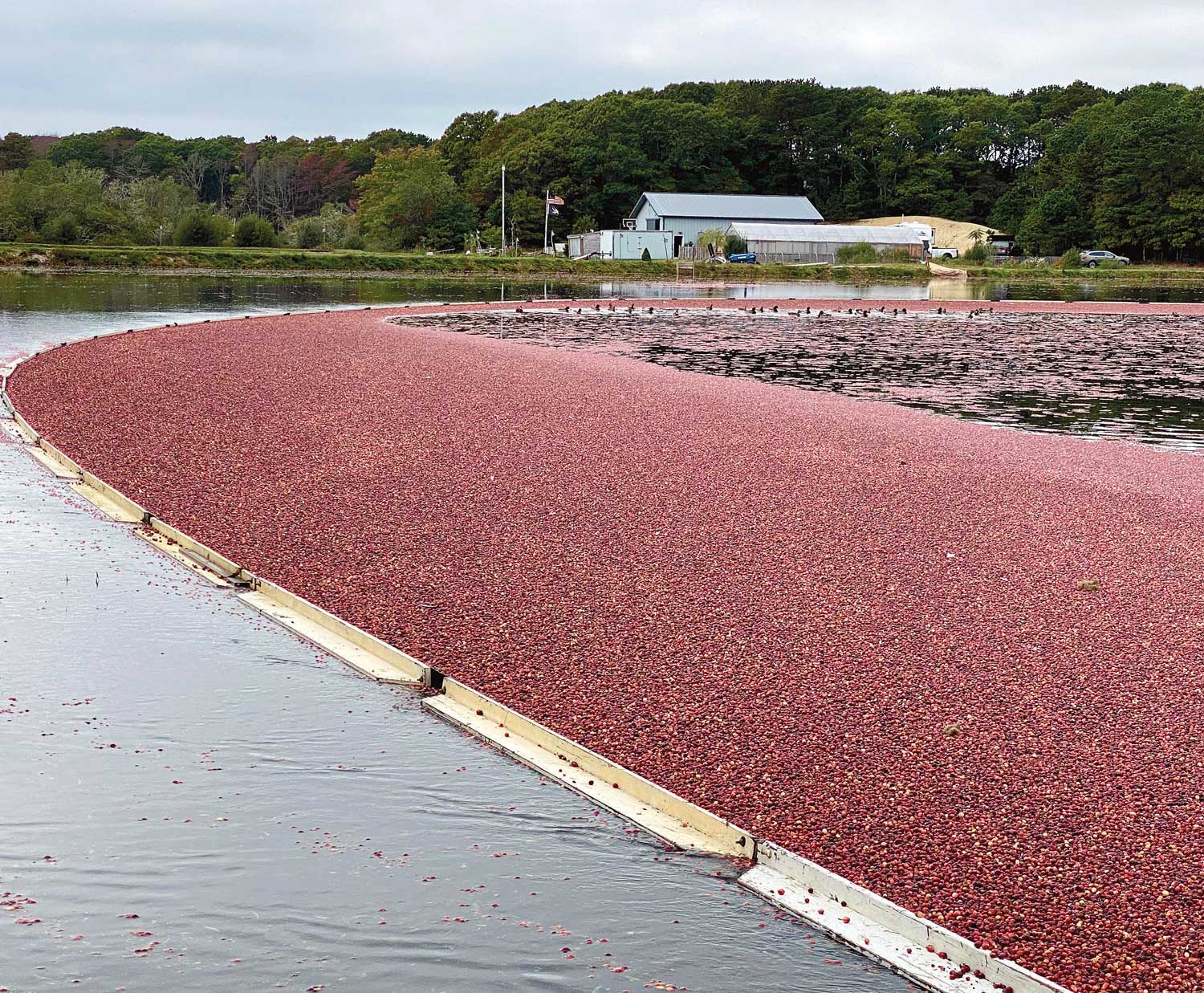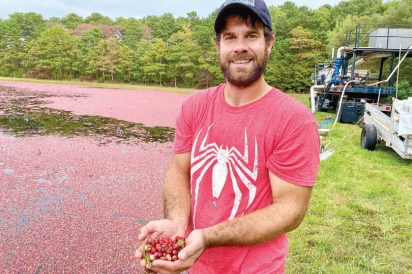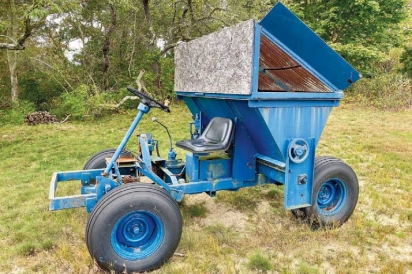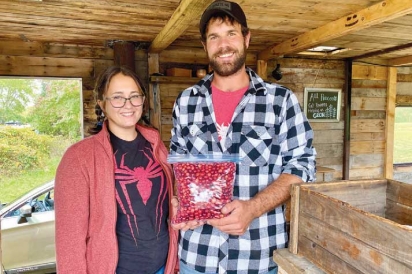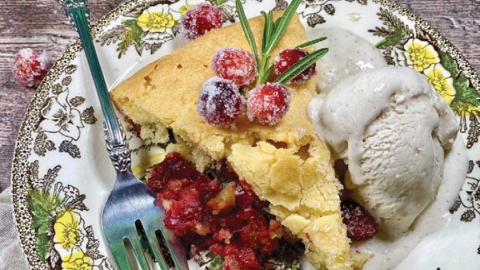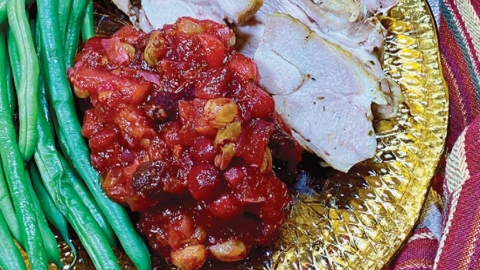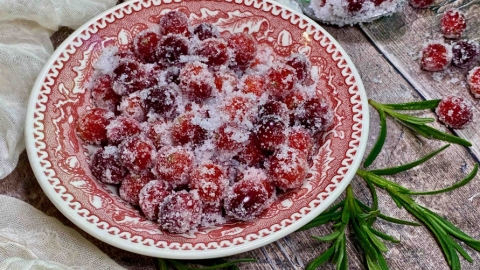A Bogside Tradition
From the Wampanoag, whose name means People of the First Light, to cranberry farmers who carry on cherished family traditions, cranberries and Cape Cod have gone hand in hand for millennia.
Fresh From the Vine, a family-run business owned and operated by Chris and Lindsay Wilson, is celebrating its 10-year anniversary selling cranberries each autumn from their farm stand on Route 28 in West Yarmouth. Because so many customers were impressed with the quality of the cranberries and repeatedly exclaimed that they were fresh from the vine, it inspired the pair to choose that phrase as their business name.
Although formal, guided tours aren’t offered, folks are free to walk around Fresh From the Vine’s property during the fall for self-guided tours. “We leave harvesting equipment out for people to see and let them experience the bog on their own. They then can come back and ask any questions they may have,” says Lindsay. In 1996, when Chris was in the third grade, he told his teacher that his family were cranberry farmers. Since that time, Station Avenue Elementary School students have toured the bog, and it’s become a cherished tradition. “They see parts of the wet harvest when the bog is flooded and the beaters are working, and they get to see the machine-operated dry harvest. They can see our 108-year-old separator at work, and how things work at the farm stand. It’s fun to be able to educate the kids and teachers about the cranberry harvest,” says Chris.
According to the Cape Cod Cranberry Growers’ Association (CCCGA), cranberries are superfoods that have unique health benefits that positively impact the entire human body. CCCGA’s website states, “Historically, the health-promoting properties of cranberries have been based on folkloric remedies, which have existed for centuries. The healthy giving properties of this fruit were recognized by Native American Indians, and early New England sailors are said to have eaten the vitamin C-rich wild cranberries to prevent scurvy.” The association also points out that cranberries contain proanthocyanidins (PACs) which are unique bioactive compounds linked to a long list of health additives in cranberries. Benefits include “reducing incidence of certain infections; promoting heart health; protecting the urinary tract; decreasing inflammation associated with chronic disease and aging; [and] supporting digestive health,” according to the CCCGA.
In 1984, Chris’s dad and uncle, Steven and Brian Wilson, began their cranberry farming careers. Their business, called Mello- Wilson Cranberry Corp., primarily sold wet harvested cranberries commercially to Decas Cranberry Products, Inc., which they still do today. Sadly, the price per barrel of cranberries plummeted in the 2000s, and ultimately Steven and Brian sold off all the cranberry properties they owned, except for the one that still exists today, and has been part of the family since 1989. “[Eventually] the two brothers lost their love of farming and let the land they once cherished slip away. Which is one of the reasons why Chris came up with the idea to sell cranberries roadside,” says Lindsay.
The inception of their farm stand happened organically. In 2012, Chris and Lindsay had been helping Chris’s dad and uncle prepare for the wet harvest. “Chris noticed a gathering of cars on Route 28 and said that we should be selling the cranberries up there. So that’s what we did. We packed up the truck and Chris’s daughter, Sesyra Wilson (who was 4 years old at the time) and headed over to sell cranberries. We filled up small plastic bags and sold them for $3 a piece, and people loved it. They would surround the truck sometimes just to ask questions. Most people don’t understand how cranberry harvesting works and it fascinated them to see the process up close,” says Lindsay. What makes Fresh From the Vine so special is this young couple’s desire to help make folks feel at home around cranberry bogs. Their friendly, easygoing mannerisms, as well as the genuine smiles that light up their faces when they talk about their business, are as refreshing as the cranberries they sell.
They began selling berries out of the back of a pickup truck, like weekend warriors. Eventually, Chris repurposed an old RV which he transformed into the farm stand you see today. One thing has stayed the same, though. “In 2013, Chris’s uncle created our sorting table, still in use today. It was used to more efficiently remove rotten and unripe berries to give customers the best possible cranberries. Throughout the years our customers have made a major impact on our lives and our motivation to continue farming,” says Lindsay.
The ruby-red, orbed beauties Chris and Lindsay grow and harvest make up the majority of their sales. But in the past, they dabbled in selling endearing, kitsch items such as mini replica cranberry bogs in glass jars and small replicas of wooden cranberry crates. “We have experimentally grown and sold various summertime vegetables but more for fun than serious business,” says Lindsay. “We even built a small produce stand on a tow-behind trailer to sell what we grew out of the greenhouse and surrounding land. Our most recent goal is to focus all of our energy on being ready for the fall season and coming up with new and creative things that can be sold during that time period.” While there have been some bumps in the road making this aspect of their dream more challenging, they haven’t given up hope.
If anyone is interested in doing a deep dive into Cape Cod’s rich cranberry history, a great place to begin would be your local library or historical society. According to Marie Kesten Zahn, Harwich Historical Society’s museum director, “the best resource on the history of the cranberry industry is Cranberry Harvest: A History of Cranberry Growing in Massachusetts, edited by Joseph D. Thomas and published in 1990.” I began devouring this book soon after I received Marie’s recommendation. After reading it, you’ll better understand how important the cranberry farmers, who arduously tend to their crops, are to Cape Cod. Thomas 1990 wrote in his foreword, “working the bogs was a brief work experience, but one that gave me an appreciation of the land, the work and the people associated with cranberry growing. And when I’m on the bogs, I am still moved by the sweet scent of pine and cedar, of damp earth seasoned with decaying vines and thriving plants. For me, it is a reminder of the good things in life.”
There are various methods used to harvest cranberries. While wet harvesting is much more exciting to watch, those cranberries are destined to be dried, or turned into juice, sauce, or concentrate. This is because they get really beat up by the wet-reel harvesters (also referred to as beaters). “Dry harvested cranberries are usually what is seen being sold in bags at grocery stores. They are hardier and last longer due to a gentler harvesting technique. They are best used for fresh recipes and baking. Only about 5% of cranberries are dry-harvested in Massachusetts,” says Chris.
Following in Chris’s dad and uncle’s footsteps, whose company has been doing it the same way since the beginning, Fresh From the Vine embraces traditional harvesting methods. Lindsay explains, “We started off with a dry harvest, old-fashioned scoop and transitioned to the motorized harvester we use today. We use the same 1/3 barrel antique wooden cranberry boxes as were used when commercial cranberry harvesting was invented.” A series of metal prongs are designed to comb the cranberries off the vine and convey them into the wooden box. A fellow cranberry farmer witnessed Chris out on the bog hand-scooping cranberries and asked if he would like a machine to help him go along quicker. “He was kind enough to gift us one of his Darlington dry-harvester machines that we use and cherish to this day,” says Lindsay. If you are lucky, you may even see Chris dancing like nobody’s watching while he dry harvests cranberries. (Facebook followers already have!)
It’s a gorgeous, sunny, 80°F day as I write this piece. All I can think about is dipping my feet in the ocean, catching up on summer reading, and eating copious amounts of ice cream. However, Chris and Lindsay have already begun thinking about next year’s cranberry growing season, which is 16 months long, and starts at the end of July. They take pride in what they do, and not only because their vines are original cultivators dating back over 100 years. The cranberry vine is a perennial plant, but it only grows about 2 inches per year. “Good vine management includes pruning the vine or sanding the vine. This entails adding 1-2 inches of clean sand over the entire bog which promotes growth, and acts as a preventative for weeds and pests,” says Chris.
Weeds and pests aren’t the only things that can negatively impact cranberry growth. There are two frost seasons that cranberry farmers have to watch out for — spring and fall. “Spring is the most crucial time to watch for temperature variations because the tolerance rises from around 15°F to 32°F as cranberry buds progress to new growth. If a frost occurs during this pivotal growth period, an entire crop could be lost,” says Chris. “Our preventative measure during a frost is to use water, either by sprinkler heads or flooding, depending on time of year. Chris has to monitor the temperature in a more traditional manner, using a glass thermometer, and maintain a keen awareness of changes in weather patterns,” says Lindsay.
The myriad challenges that exist in the world of cranberry farming might deter some people from embracing it as their chosen profession. Not Chris. “My passion for cranberry farming definitely started in my childhood. Getting those rare chances to skip school and go to work with my dad is one of my greatest childhood memories. Especially during harvest season,” says Chris. “The smell of the bogs on a cool autumn morning, just before the sun rises, is very unique and a sure sign that it’s harvest time. Throughout my childhood my family managed and owned many bogs throughout eastern Massachusetts. So, I got to experience and help work all these different properties all over cranberry country. Learning the craft of cranberry farming was all guided by my uncle and father,” says Chris.
Despite Chris’s family trying to discourage him from going into cranberry farming himself (it can be a fickle mistress), he has wholeheartedly embraced it for nearly a decade, as has his wife, Lindsay. During the spring of 2013, in an effort to save money, he came up with a radical idea. “With my father and uncle’s permission, I decided to move into a campsite that I built on the bog in Yarmouth. For the next nine months Lindsay and I lived in a small tent in the woods just outside the barn. It was quite the experience, roughing it like that throughout the seasons. Dealing with the cold, the storms, the wildlife. It’s where our love of the ecosystem of the farm began, and when I knew it was time to put more effort in protecting the environment,” says Chris. Chris and Lindsay continued helping with cranberry harvesting while pursuing their other careers — nursing school for Lindsay, and landscape construction for Chris. But there was just something special about selling cranberries directly to the public that really spoke to them. “We hand painted signs and put equipment on display. The love for the community started growing at this point. It wasn’t the sale of fruit that attracted us to it, but the friendliness of the community and visitors that drove us to keep going,” says Lindsay.
Due to a variety of reasons, 2018 was a really challenging year. Chris’s dad and uncle’s cranberry farm was really hurting. This motivated Chris and Lindsay to put all their extra time into trying to save the farm. “That summer I started writing my business plan and built the farm stand that’s there today. I experimented with different produce and found I not only love to grow fruit, I’m actually pretty good at it,” says Chris. The new farm stand was a massive success. “Tour buses stopped by, locals absolutely loved it, and visitors had a full time — no matter the weather — place to stop to buy the freshest cranberries. This is when I knew what I wanted to be for the rest of my life. A community farmer!” says Chris.
Is it worth it to pursue a dream? This couple believes so. We all know what happens to a dream deferred, and Chris and Lindsay didn’t want that to happen. So, Lindsay worked long hours as a nurse, and gave Chris the financial backing he needed to go to school himself. Chris’s daughter helped work the farm stand, and Chris spent the next two years learning how to be a successful farmer, and identifying what success meant to him. “We worked hard toward our goal, and finally came to a decision on how we want to grow our farm business,” says Chris.
It’s heartwarming to see a couple grow their dream together, even if the trajectory of that business is not etched in stone. Just like the steadfast, centenarian cranberry vines’ strong connection to the land, so are Chris and Lindsay’s commitment to its betterment.
Fresh From the Vine
300 Main Street, West Yarmouth
www.facebook.com/StayFreshFarms
www.instagram.com/fresh.from.the.vine


